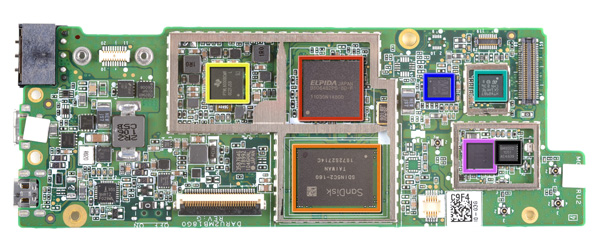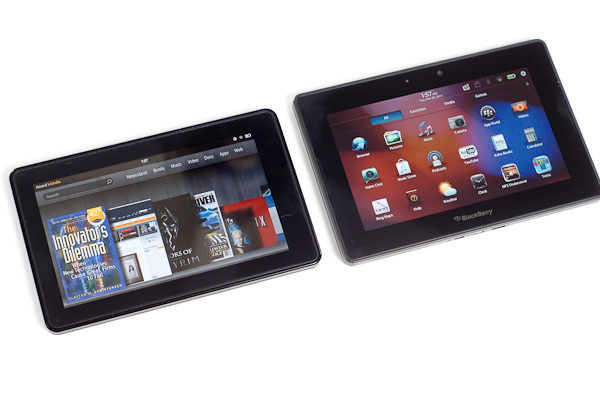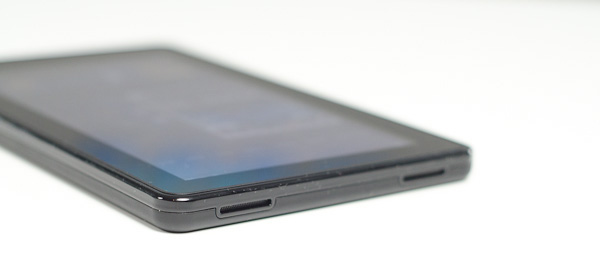Amazon Kindle Fire Review
by Anand Lal Shimpi & Vivek Gowri on November 29, 2011 3:31 AM EST- Posted in
- Tablets
- Mobile
- Amazon
- Kindle Fire
- Kindle
Mario Twins
Rumor had it that in order to save time (and likely cost) in bringing the Fire to market, Amazon had opted to use the same design as the BlackBerry PlayBook courtesy of the ODM that made both: Quanta.
ODMs like Quanta will build anything you want or they'll do slight modifications to an existing design to suit your needs. The idea is you don't need to be an expert at everything. If your differentiation is primarily software and you just need a fast hardware platform, Quanta (or Pegasus or Foxconn, etc...) will give you that and let you roll your own software stack on top of it. It's not all that uncommon in the industry. This is actually how companies like Marvell work in the SSD space as well. They'll give you the hardware, but the most successful drive makers simply use the Marvell hardware as a base platform - they all write their own firmware.
Aesthetically, the Kindle Fire looks a lot like the PlayBook. The dimensions, screen size/resolution and even build quality are eerily reminiscent of one another although the PlayBook is tangibly larger. Both tablets have a large screen bezel (the PB's is bigger) and soft touch plastic on the back. The power/lock button on the Kindle Fire is also quite similar to what's used on the PlayBook. It's in a different location and is much easier to actuate but it's clear that even the buttons came from a similar parts bin.
A look inside both devices shows a different arrangement of components and a different layout on each motherboard. Our own Brian Klug spotted a curious reference on each board however: the PlayBook's board is labeled Rev. G while the Fire's board is labeled Rev. F. Is it possible that the two boards are simply different revisions of one another?

Image Courtesy iFixit - Kindle Fire Motherboard

Image Courtesy iFixit - Kindle Fire Motherboard
Either way it's clear Amazon departed from its usual unique design approach with the Kindle Fire. While previous Kindles were fairly recognizable among a sea of devices, the Kindle Fire looks and feels like a PlayBook. In fact, when it's off and sitting on your desk, you'd be hard pressed to tell that it was something made by Amazon. The large 'kindle' lettering on the back was likely designed to address this brand identity issue, but it really was the only thing Amazon could have done given the generic looking platform.
Looks aren't a major concern of mine but I do wonder what we can conclude from this. Either the Kindle Fire was a rushed project to catch the 2011 holiday shopping season or it's a sign that value tablets can't look very special, or perhaps both?
Simplicity in Hardware
Despite the physical similarities to the PlayBook, Amazon whittled down the number of buttons on the Kindle Fire to just one: power/lock. Volume controls are entirely in software, and to be honest I don't miss the physical buttons. As this isn't a smartphone, I don't need to worry about quickly silencing a ring or increasing the volume of a call. The tradeoff here makes sense.
As I mentioned before, the round power/lock button is easy to actuate. The bigger problem is the button's location: at the bottom of the Kindle Fire. On the bright side it does keep the button out of your way when you're reading, it just happens to be in the exact opposite location of where years of using modern smartphones/tablets have taught us to expect it. Then again, an oddly placed power/lock button isn't too big of a deal when you've got a configurable software screen lock.
A 1/8-inch headphone jack and micro USB port keep the power/lock button company. Amazon doesn't ship the fire with a micro USB cable, instead you just get a power brick with a micro USB end for charging the Fire. To Amazon's credit, to use the Fire as a Kindle you never need to hook it up to your Mac or PC. A standard USB cable is only really needed for getting your own music, videos or apps onto the device.
There are a pair of stereo speakers on the opposite end of the device. The volume control feels non-linear and the speakers get loud enough to make their position a bit awkward. Hearing loud noises from one side of the device and not the other isn't really desirable, particularly since you'll likely be watching movies on the Kindle Fire in landscape mode.













70 Comments
View All Comments
Reflex - Tuesday, November 29, 2011 - link
No, part of the reason Amazon forked Android was to eliminate Google services and analytics. No Google account required, nothing is shared with Google unless you choose to install their apps and services. Amazon also has very strict privacy policies and does not share user information with anyone(even internally from what I understand).stationstops - Tuesday, November 29, 2011 - link
As a commuter, I am on my iPad2 3 hours a day. I would love to try the Kindle Fire as a less cumbersome replacement (for me, it either fits in the pocket of the sport coat or it doesn't), but without 3G, there is absolutely no productivity for me here at all.Its kind of amazing how little importance 3G is given in the press when discussing Android tablets. They commonly get released with no 3G version at all, and when the 3G versions do come out, they have contracts and pricing which simply can't compete with iPad's liberal Verizon and AT&T month-to-month plans.
Keep in mind that this great 2011 tablet computer has worse connectivity then a Gen 1 Kindle.
melgross - Tuesday, November 29, 2011 - link
It's interesting that most reviews from Anand pick apart even the smallest problems, but this review seems to gloss over them. Is it really possible that Anand and Vivek didn't have the problems that other reviewers had?Problems mentioned in other reviews include, turning off the tablet when watching movies, browsing, or doing any activity because of the poor placement and implementation of the
Owner button.
The need to often tap several times to get the screen to respond, or to find that the tablet did, after a lag, detect a tap, but now moves you to something else because you tapped too often.
The lack not only of a microphone, but a rear and front camera, so no Skype possible.
Also no gyro. Amazon doesn't allow apps in their store if it uses any of these features.
Many side loaded apps either don't work, or have problems if they do. And sideloading apps isn't for the average user anyway, so most are stuck with what Amazon approves, which isn't much.
Many tap points are small (and as mentioned, not always responsive), and so people with vision problems or motor control problems will have difficulty with this.
Overall, this isn't such a great product. I'm surprised that Anand didn't go more deeply into this. There's no excuse that it's just $200. For that we should get something that lacks features, but it should still work well for what it does.
Wizzdo - Tuesday, November 29, 2011 - link
I agree. I feel this review isn't up to the usual high standards. The points melgross states are quite salient. Anand mentions that the Kindle Fire is no iPad 2 but this is for many more reasons than size and graphics horsepower alone.cat12 - Tuesday, November 29, 2011 - link
I have own a older molder kindle (purchased 6 months ago) I was very pleased with it and still am. Well I had to try the fire. I did not like the back light at all. When you work on computers all day you eyes fatigue. With the older kindle seems like you are reading a book and is much easier on the eyes.As far as the internet web browsing it was redundant since I have laptop etc... The film quaility of the movies on the fire was excellent but again redundant.
Also I could view my external mail account but could not open the messages, so it was useless as a business tool. The fire seems to be much heavier, and do not think for a moment that you can use your old protective cover for the fire. You will have to lay out cash for a new one to fit the fire.
I returned the fire after a couple of days and am awaiting my refund from amazon. I will continue to enjoy my older kindle for the "book" reading experience, after all that is why I wanted a kindle in the first place.
NCM - Tuesday, November 29, 2011 - link
"Amazon refused to skimp in two areas: compute and the display.""this is more general purpose compute..."
Please: "compute" is a verb, not a noun.
bludragon - Tuesday, November 29, 2011 - link
This is my single biggest gripe with the browser, especially in landscape, most of the screen is wasted on the buttons and status bar. Unless I'm being really dumb and missed the option to get rid?Aside from Netflix, nothing I searched for in the app store was there. I don't think I'm asking a lot...
1. Zinio
2. Google maps
3. Yelp
4. Firefox, opera or some other web browser to get around the browser irks and the few buggy web sites (typically where pop up ads prevent you from seeing the page, or you can't select things on pop up menus)
Bazili - Tuesday, November 29, 2011 - link
It's time to create a device with both displays and a simple smart cover that shifts the device from one mode to another.Isn't it possible, is it?
VivekGowri - Wednesday, November 30, 2011 - link
The NotionInk Adam is a similar idea to what you're talking about.geniekid - Tuesday, November 29, 2011 - link
A lot of people say they don't understand the comparison between the Fire and an iPad, but I think there's value to such a comparison.Yes, I KNOW the iPad is obviously a superior piece of hardware to the Fire and it was designed to meet different needs. I need to know EXACTLY what those different needs are. What does that extra $400 dollars buy me? I would guess at least half the people reading reviews about the Fire want to know how it compares to the iPad, EVEN IF THEY ALREADY UNDERSTAND that the two are targeting different demographics.